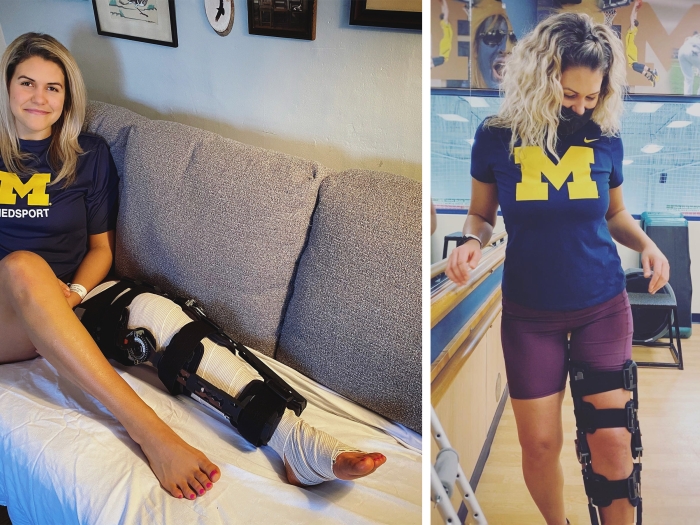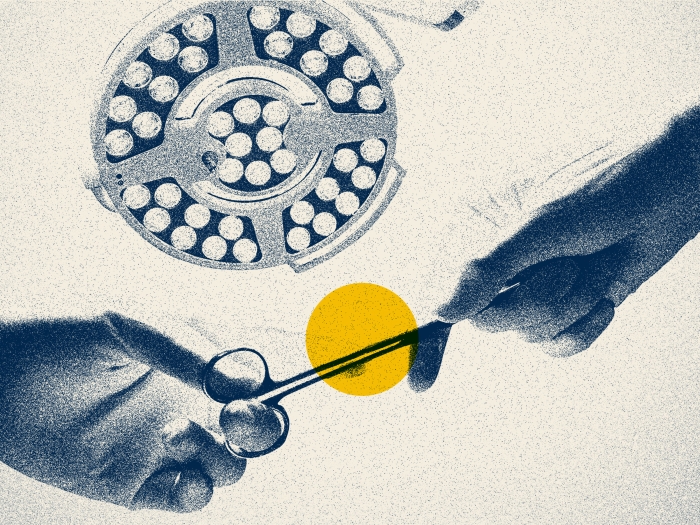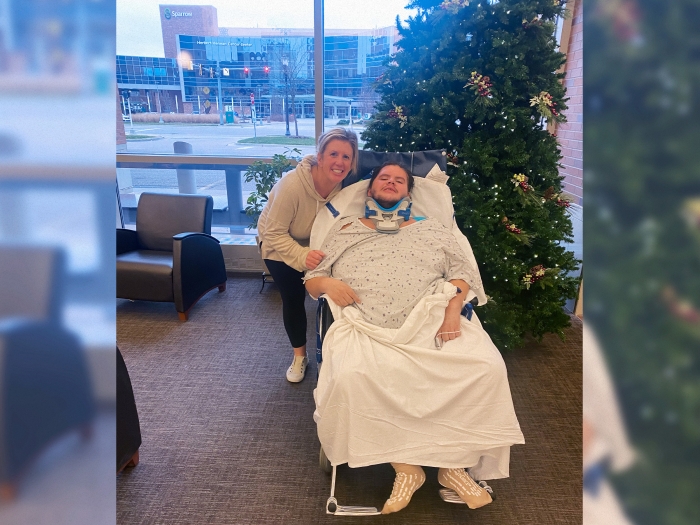How Michigan Medicine helped one patient get back to mobility and life after a seven-story fall left him critically injured and paralyzed.
12:45 PM
Author |
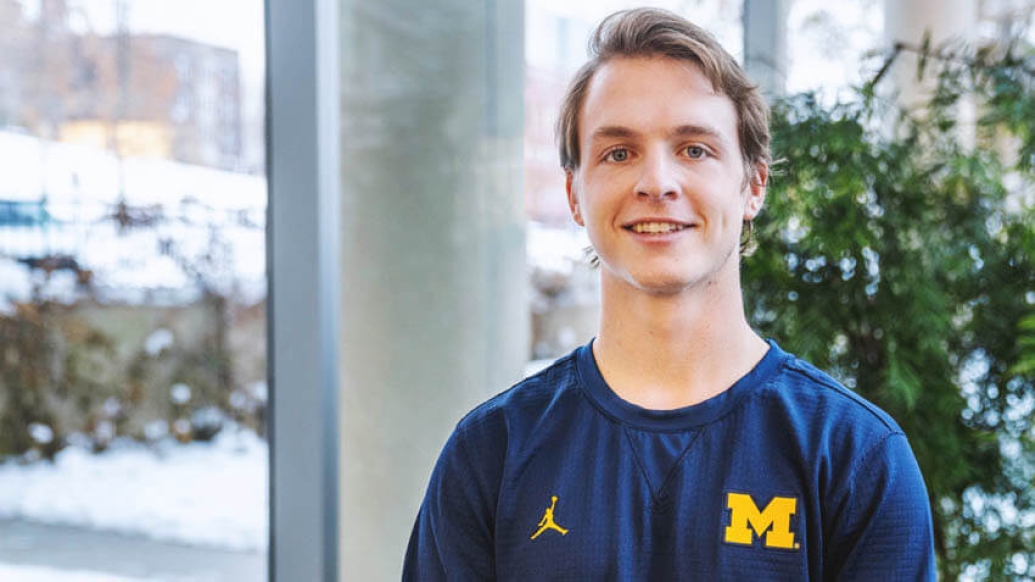
When Greg Aikens woke up from a coma after a seven-story fall from a parking garage, he was understandably confused.
"I slowly began to realize how severe the situation was," says Aikens, a 22-year-old student at the University of Michigan. "I woke up eight days after the fall and it was very confusing. It was hard to tell whether the things happening around me were real or just in my head."
The accident, in October 2016, left Aikens unconscious with a frightening list of injuries: a shattered left elbow, open fractures in both tibias and fibulas in his legs, fractures in his left foot and right ankle, a severed pelvis injury, and damage to his chest, bladder and liver, among other injuries to his arteries, skin and head.
He was rushed to Michigan Medicine where he immediately went into the operating room for surgery to his intra-abdominal organs and blood vessels. He would need multiple surgeries to repair all of the damage followed by an extended stay in the Michigan Medicine Trauma Burn Center Intensive Care Unit.
"It was a very complex case because of the number of injuries he had sustained and the severity of those injuries," says Jill Cherry-Bukowiec, M.D., an associate professor of surgery at Michigan Medicine and Aikens' first surgeon.
'The limb- and life-saving phase'
The first few days of Aikens time spent at Michigan Medicine was what James Goulet, M.D., a professor of orthopaedic trauma surgery and the lead on Aikens' orthopaedic procedures, called the "limb- and life-saving phase."
After Cherry-Bukowiec and team performed an exploratory laparotomy, a surgery to open the abdomen and examine the abdominal organs, they were able to repair Aikens' damaged gastrointestinal organs and created a temporary colostomy to be used while the organs were healing.
Next, Chandu Vemuri, M.D., an assistant professor of vascular surgery at Michigan Medicine, performed a vascular surgery in which he repaired the posterior tibial artery, the artery that carries blood down to the bottom of the leg and foot, in Aikens' right calf.
"That surgery was critical to saving Greg's right foot," Goulet says. "Without the expertise of Dr. Vemuri and his team, we would have had to consider amputating Greg's foot."
Even though Aikens was in a coma and on a ventilator, he had experienced trauma to his head during the accident that required him to undergo intracranial pressure monitoring, a procedure where a probe is inserted through the skull to measure how much pressure is in the brain. If the pressure is too high, it can lead to serious brain and nervous system injury. Aikens' results showed his brain pressure appeared fine.
Over the next few days, Aikens had multiple orthopaedic surgeries to fix the injuries in his back, legs, arm and foot.
"Greg's pelvic injury was more complicated than a typical pelvic ring injury," Goulet says. "The injury extended into his lower spine, which occurs almost exclusively in high-energy injuries. We used plates and screws to secure the pelvic fractures."
Goulet also says that Aikens' nerve injuries were a serious concern.
"The neurosurgical team coordinated with us to stabilize the spine adjacent to the pelvis and to decompress the nerve roots," he says. "When you have an injury like Greg had in the lower back region, the team won't know at the time if he experienced central or peripheral nervous system injury. If he experienced a central nervous system injury, there's little chance of that being restored. Luckily, it was mainly peripheral nervous injury in his back, which meant much of his muscle function could be restored over time."
In addition to Goulet, Aikens' orthopaedic surgery care team included James Carpenter, M.D., Aaron Perdue, M.D., Aidin Eslam Pour, M.D., Paul Talusan, M.D., and Jeffrey Lawton, M.D. He also had a skin graft performed by plastic surgeon Adeyiza Momoh, M.D.
"Greg is the reason we do what we do," Goulet says. "It speaks to how severe his injuries were that we needed to involve so many different physicians and specialties from across Michigan Medicine to make sure he received the best care possible. All of the care providers, not just physicians, are called to intervene at unscheduled and often late hours, and do this without hesitation for our patients."
Eight days after the accident and with many surgeries behind him, Aikens began to come out of his coma.
"The doctors had warned us that he might not be the same when he woke up," says Linda Aikens, Greg's mother. "But as soon as he opened his eyes, we knew it was still Greg. His humor started coming back over the next few days and that's when we really knew it was the same Greg."
Aikens also required so much blood over the course of his stay in the hospital that Linda makes it a goal to give blood as much as possible because she knows how much it can help those that need it.
"Each surgery really brought success and life back to Greg," Linda says. "The nursing care was unbelievable. And when Dr. Matthew Delano was slowly weaning him off of the ventilator and taking out staples, stitches, catheters and casts over the coming weeks, I still remember him saying to me that he wished all patients were as determined to heal as Greg."
Aikens adds, "The one-on-one care from my physicians really made a difference for me in recovery."
In addition, the Aikens family found support in their community and from family friend, Kim Eagle, M.D., a cardiologist and a director of the Frankel Cardiovascular Center at Michigan Medicine.
"The waiting room was constantly filled with students, friends and family sitting vigil with us through the grueling days of surgeries and the agony of the unknown," Linda says.
And she mentions support even came sometimes from where they least expected it.
"My husband, Bruce, left defeated one night after a particularly brutal day and he said 'see you tomorrow' to the valet attendant," Linda says. "The attendant said that was a good thing because that meant Greg was still alive. Everyone made such an impression on us, down to the tiniest things."
'The recovery phase'
After weeks in the hospital, Aikens was cleared to go home and start his recovery.
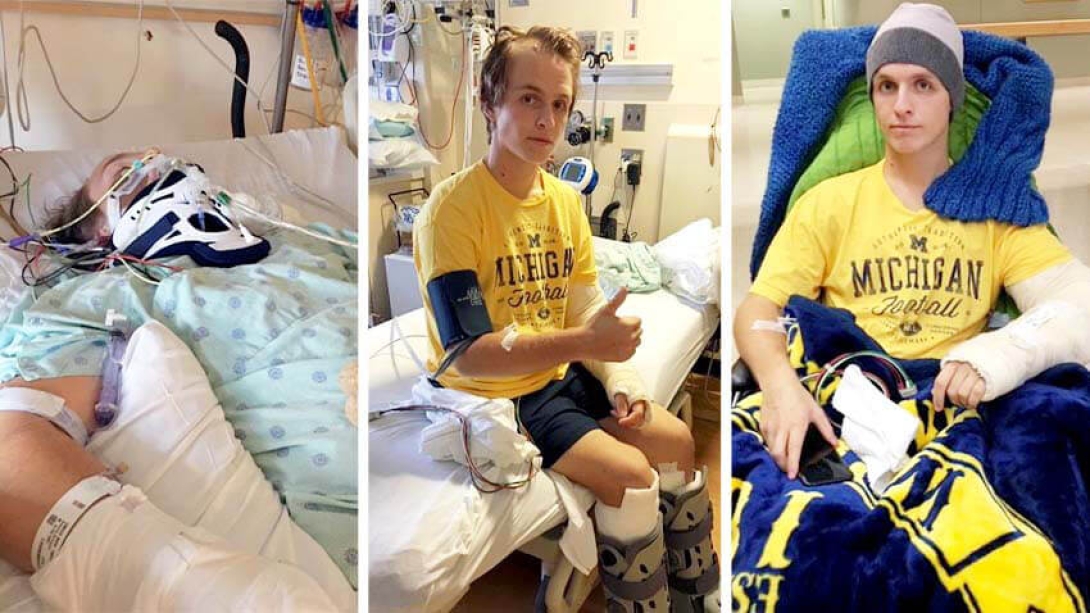
"The recovery phase is a whole lot longer than the high-adrenaline life-saving phase," Goulet says. "Greg and his family knew that recovery wasn't going to happen in a month or two and they had the strength and determination to keep going."
Aikens says the recovery phase has been difficult, especially at the beginning.
"There was so much wound care to deal with and basic movements, such as sitting up or bending my knees, were extremely painful," Aikens says. "I was being fully taken care of by my family, and since I was always in so much pain, it made it hard to communicate."
After about three months of in-home physical therapy sessions where he tried to move his limbs as much as was allowed by his care team, Aikens was cleared to begin bearing weight on his legs, and then was cleared for his left elbow a few months later.
Because he was an active athlete before the accident, Goulet and Carpenter thought Aikens might be more motivated during physical therapy sessions if he attended a site near his home that catered to athletes his age.
"I made a great connection with my physical therapist, Mike Haumesser at Barwis Methods, who helped me stand up for the first time and learn how to walk again over the course of the next several months," Aikens says. "Most muscles in my body were tender and atrophied, in addition to the paralysis and nerve damage down my left leg, and he really listened to me, worked with me and pushed me to get to a place where I could feel confident on my own again."
He adds, "And I continued going to U-M for occupational and physical therapy on my arm."
"It's really a pivotal point for patients when they begin to see improvement," Goulet says. "It can help them muster the energy to keep moving forward."
While recovery was going well, it wasn't without some setbacks.
"I tried to go back to college for that winter semester just doing an online class, but the pain was still too intense to concentrate and I needed to put my full focus into my recovery," Aikens says.
Six months after the accident, it was time to remove Aikens' colostomy bag and have him begin using the bathroom on his own.
"I was in the hospital for five days after that surgery, and I honestly didn't realize how difficult that would be for me," he says.
His legs are still a source of angst.
"Living with the foot drop and paralysis in my left leg is still my biggest challenge," Aikens says. "At first it was frustrating, but now I am continuing to learn how to use my body in adapted ways to do the things that I love."
Aikens has also worked with doctors on pain management and his mental health since the accident.
"With the support of my Michigan Medicine team, I went to the Mayo Clinic Pain Rehabilitation Clinic for a few weeks to learn how to manage the chronic pain and symptoms on a day-to-day basis and wean off of medications," he says. "And I continue to work on my post-traumatic stress disorder and mental health that was affected by the accident. Managing my mental health has been key in my motivation to recover."
Looking towards the future
Now, three years after the accident, Aikens notes that his chronic pain is still a struggle, as well as the injuries to his legs, pelvis and back.
"We know my legs aren't going to be fully back to normal, so we're constantly exploring what we can do to make things easier," he says.
Goulet adds, "Greg has been very interested in and dedicated to his recovery and health the entire time. He works hard to understand what's happening and is continuously on the alert for new and promising interventions."
For Aikens that meant exploring some new medical procedures to see what might happen.
"I'm always looking for what more I can do to improve my situation," he says. "I've been looking into stem cell research, and I have already had a platelet-rich plasma injection in my right ankle, but it was hard to tell how much it benefited me."
Getting back to college as a full-time student at U-M was one of his main goals throughout the recovery process.
"I'm back at school living with some of my best friends, and it feels great to get back to a more normal routine," Aikens says.
He plans to graduate next year and wants to help those that may go through something similar to him after graduation.
"I'm majoring in biopsychology, cognition and neuroscience, and hope to pursue a master's degree in the future," Aikens says. "I'd like to work with braces and other medical technology to help people with some of the issues that I have faced. More comfortable, sturdy and light-weight braces, crutches and other aids made my recovery a lot easier and more manageable. But there is still much room for improvement, and I would love to use my experience to help others."
In addition to being back in school, Aikens has been looking to get back to his athletic side.
"I was big into playing sports, skiing and various outdoor activities," he says. "Now I'm looking into getting back out there with my friends and family."
Goulet is still amazed by Aikens and where he is now.
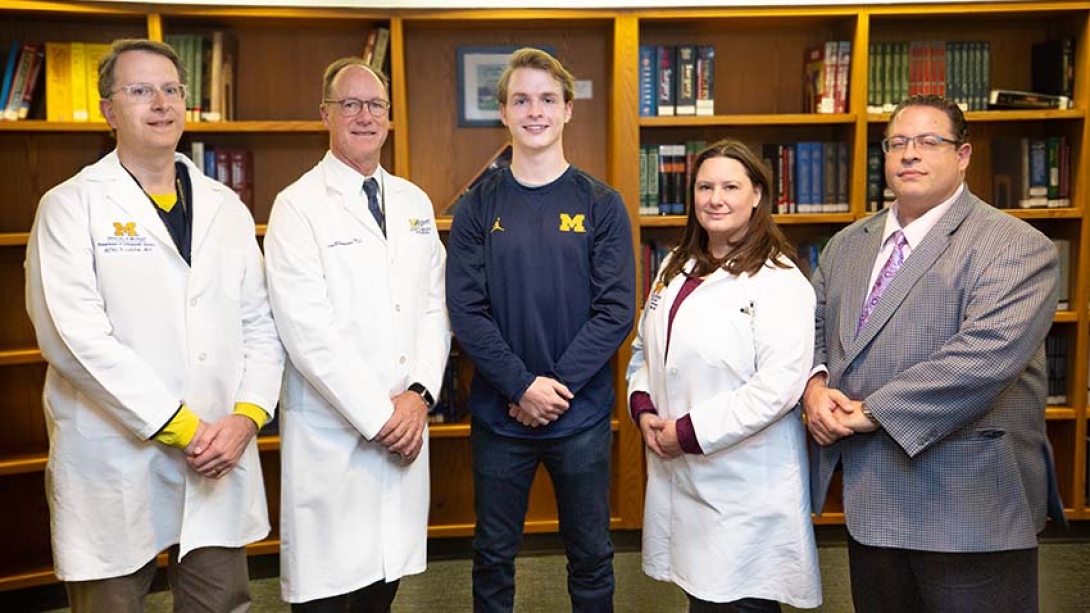
"For the combination of nerve injuries, vessel injuries, organ damage, and severe fractures he had, each could individually impair his function," Goulet says. "But when you put them all together, it's very unusual for somebody to have the results he has had. A lot of effort goes into that care from not only our patient care team, but from Greg and his family.
"Greg's elbow is a great example of that effort. That fracture was extremely complicated. But the fact he has no issues with it now speaks to Dr. Lawton's expertise and to Greg's willingness to fully participate in difficult and sometimes painful therapy for his elbow."
Linda adds, "My family and I want to express our gratitude to all of the surgeons and staff that literally saved Greg's life, and put him back together again. We are also so grateful to Greg for his strength and perseverance; his will to live and walk again.
"Although the weeks that followed Greg's accident were some of the hardest days of our lives, they were also some of the best in that each surgery was a tiny miracle, and each day brought us closer as a family and to bringing Greg home."
Aikens agrees, "I would not be here today if it were not for the doctors mentioned, the rest of my Michigan Medicine care team, my family and my close friends that were there with me through all of the ups and downs. Their patience, understanding, strength and empathy made a really frightening and unknown situation a little bit more bearable."
He adds, "As my recovery continues, with surgeries and other medical interventions to come, I feel confident with my team here at Michigan Medicine. Although I cannot name them all, I am beyond thankful for everyone who helped me get on my feet again, and no words will ever be able to express my gratitude."

Explore a variety of health care news & stories by visiting the Health Lab home page for more articles.

Department of Communication at Michigan Medicine
Want top health & research news weekly? Sign up for Health Lab’s newsletters today!



